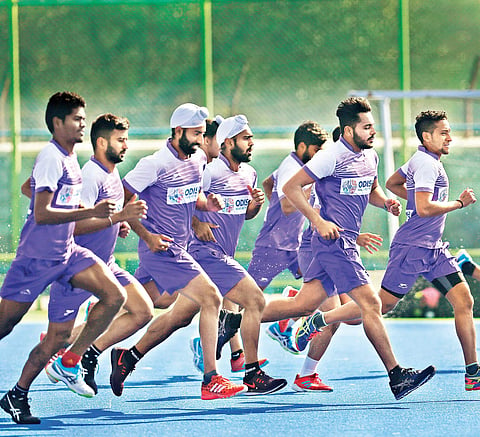

CHENNAI: When the Indian squad for the Invitational 4-Nations tournament to New Zealand was announced, the spotlight was on PR Sreejesh’s comeback from injury and the high number of debutants — four — in the team. Another thing escaped attention. The number of players in the squad. Twenty.
No Indian men’s squad in recent memory had named 20 players for a single series. While that is mainly because FIH mandates a maximum of 18 in blue riband meets, the management went ahead with 20 in a warm-up meet for two reasons. To see how players reacted under pressure and to blood players who had an outside chance of making the Commonwealth Games squad if they showed the right aptitude.
Out of the debutants — Krishan Pathak, Simranjeet Singh, Vivek Sagar Prasad and Dilpreet Singh — two made the CWG squad. Both impressed coach Sjoerd Marijne and the team management preferred them over the likes of Ramandeep Singh, a striker who has over 100 caps to his credit. This was the sort of forward planning that Hockey India undertook before naming the 18-man squad.
By design
Five minutes in the company of Marijne and he makes a compelling case to suggest all of this was by design. “I have seen around 50 players (36 in competitive matchplay) since taking over,” he tells Express. “What we have learned over the last four tournaments is how players deal with pressure and how their learning curve is (fast or slow).
“Are they learning fast with all the advice we are giving them? Or are they slow learners? Most of those who played (since the Asia Cup) have played at least two tourneys besides being part of training camps. So we have had an eye over all of their developments in this period. We know which player is better.”
This obviously went into naming the final squad but they were also on the lookout for players who were receptive to advice. They didn’t want anybody with poor attitude. “It’s important that with all the advice you give to players, they do something about it. They must be able to learn. If not, that’s going to be a long process. We have talented players but talent alone doesn’t make players great. It’s about adapting and learning.”
It’s obvious that Vivek — who may very well have died on the operating table following a broken collarbone if it were not for quick-thinking doctors — and Dilpreet have already made an impression. Captain Manpreet Singh just can’t have enough of them. “Both played very well in New Zealand... scored goals,” he says. “Even in the ongoing camp, they have not only shown promise but have improved.”
No sentimentality
The other aspect about India’s planning is they have not selected based on sentimentality. They do not want passengers in a side that prefers to use speed as a means to kill opponents. While Manpreet did not name the likes of Sardar Singh, it was clear the team management had decided to dump him because of the yard of pace and speed of thought he has lost in the last few years.
“Whenever we receive the ball, our idea is to move forwards,” Manpreet points out. “To pass it forward because we are a team that thrives on speed. We have the likes of Akashdeep (Singh), SV (Sunil) and Gurjant (Singh) who are quick. We are working on attacking structure and we are trained to see whether the forward pass is on. Only if it’s not on do we pass sideways or go back.”
It’s obvious that the core group embraced the new player-driven structure but Marijne was still not satisfied. So he brought on board Australian World Cup winner Chris Ciriello. Ciriello played an active part in Australia’s leadership hierarchy during the 2014 World Cup and the Dutch coach felt that sort of know-how will help the Indian team.
Of course, India may still fail. Nobody hands out gold medals for being well prepared. Marijne knows that. “The answer is a stretch but ourselves,” he says when talking about who India should the fear the most. “I’m not thinking about semifinals or final. If we beat our own challenges of being consistent, I don’t think we will have to fear anyone.”
The clarion call has been raised. The first response to that will be against Pakistan.
14 Teams India have played against since the Asia Cup, in 26 matches
20 No of players who went on the tour to New Zealand. Usually, only 18 players are taken to tournaments
36 No of players the team management has tried since Sjoerd Marijne came on board before the
Asia Cup
1 Varun Kumar is the only player to have played all 4 tournaments under the new regime
5 Only 5 of the 18 players in the CWG squad have not played at least more than one tune-up tournament (since Asia Cup, October 2017)
swaroop@newindianexpress.com